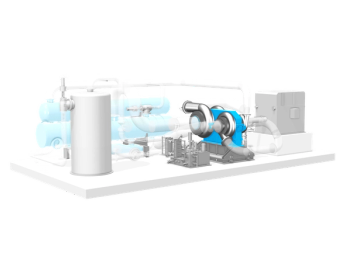
Reducing power losses in tilt pad bearings
Running hydrodynamic bearings in an evacuated condition can reduce power loss and pad operating temperatures. Evacuated, directed or leading edge lubrication implies similar lubrication mechanisms where oil is introduced to the pad leading edge via some sort of groove or spray nozzle arrangement, and excess oil (oil not going into the pad leading edge) is encouraged to leave the bearing to minimize churning losses.
This article contains excerpts from the paper, "The effect of starvation on the dynamic properties of tilting pad journal bearings" presented at the 2015 Turbomachinery Symposium by John K. Whalen of John Crane, Minhui He of BRG Machinery Consulting, Vaclav Cerny of Doosan Skoda Power and Vaclav Polreich of Doosan Skoda Power.
Bielec and Leopard (1970) describe the results of testing performed with tilting pad thrust bearings and stated: “The use of directed lubrication in high-speed thrust assemblies achieves substantial reductions in power absorbed, at the same time reducing the pad surface temperature and increasing the film thickness.”
Most bearing vendors employ one or more of the evacuated lubrication schemes described above for some of their thrust bearing offerings. As acceptance of this concept increased researchers investigated utilizing similar lubrication schemes in tilting pad journal bearings.
Tilting pad journal bearings that run evacuated are commonly designed without end seals and therefore the bearing shell is not flooded with oil. By severely limiting the flow of oil to a journal bearing unloaded pads in the bearing can run starved; that is there is insufficient oil available for every pad to run with a full film of oil from the pad leading to trailing edge. This is in stark contrast to thrust bearings where all pads theoretically are loaded evenly.
Tanaka (1991) was one of the first to discuss running TPJ’s evacuated and presents test and analytical work to introduce the concept. He found that pad operating temperatures could be reduced and loaded pad oil film thicknesses increased with these lubrication schemes and that was - and has been - an important consideration with high speed turbomachinery.
Tanaka did not address the starvation of unloaded pads in his work but did get good correlation with his pad temperatures, especially on the unloaded pads. His rig was static only and as such could not extract stiffness and damping coefficients and his theoretical results did not present dynamic coefficients.
Harangozo, et al. (1991) tested a TPJ with various lubrication schemes but again did not test or discuss dynamics. They reported pad temperature and power loss reductions are possible by utilizing evacuated designs. They also concluded that the benefits of running evacuated are not nearly as great as those achieved with thrust bearings.
Dmochowski, et al. (1993) and Brockwell et al, (1994) presented the first of several papers on the leading edge groove (LEG) journal bearing design. Here significant reductions in pad temperature were reported, attributed to the reduction in hot oil carryover. Also reported were reductions in power loss and the amount of oil required to be supplied to the bearing. They did mention: “Furthermore, there was no noticeable difference in the dynamic characteristics of the rotor between the flooded and leading edge groove bearing designs” but did not present any dynamic bearing data in the paper.
Edney, et al. (1996) and Edney, et al. (1998) discuss issues found with lightly loaded LEG journal bearings in high speed, light load applications. Steam turbines experienced unstable operation and higher than predicated first mode amplification factors when fitted with LEG TPJ’s. They theorized that the low eccentricity ratios caused the pads to become unstable and solved the problem by introducing a profile after the groove. As with other work in evacuated TPJ’s; they also reported lower pad temperatures, lower power loss and less oil required.
Nicholas (2003) presented a bearing design utilizing directed lubrication to reduce pad temperatures in high speed, heavily loaded bearings. These bearing designs utilize several design techniques to reduce pad temperatures, including the use of: • Copper alloy pad materials • Offset pivots • Directed lubrication (running evacuated) • “Spray Bar Blockers” (to reduce hot oil carryover) • By-pass cooling where extra oil is introduced behind the pad to increase heat transfer. Whereas a lot of static data was presented illustrating the successful application of these features in very high speed/high load applications, no specific bearing dynamic testing was performed.
Nicholas does however mention that “The low housing pressures created by evacuated housings can lead to oil starvation and subsynchronous vibration if improperly applied.” Here he discusses that not properly distributing the oil along the pad axial length may lead to select portions of the pad being starved, resulting in a dry friction rub and subsynchronous vibration.
Running evacuated bearings in at-speed balance facilities under vacuum conditions is also discussed. Here the vacuum can cause the oil to atomize as it leaves the orifices, thereby starving the entire bearing. This potential problem can be addressed by utilizing dummy end seals to ensure the bearing is flooded with oil when in a vacuum. He (2003) and He, et al. (2005) describe how pad starvation can be accounted for in Thermohydrodynamic (THD) modeling of evacuated TPJ’s. Here not only are pad temperatures and bearing power loss addressed but bearing dynamic coefficients when running with some pads starved or partially starved are calculated.
Newsletter
Power your knowledge with the latest in turbine technology, engineering advances, and energy solutions—subscribe to Turbomachinery International today.




